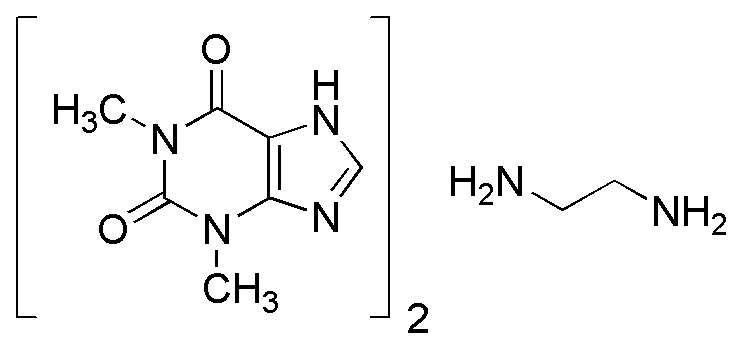Aminophylline is widely utilized in research focused on:
- Respiratory Medicine: It is commonly used as a bronchodilator to treat asthma and chronic obstructive pulmonary disease (COPD), helping to relax the muscles in the airways and improve breathing.
- Cardiovascular Research: Researchers explore its effects on heart function, particularly in cases of congestive heart failure, where it may help improve blood flow and reduce symptoms.
- Pharmaceutical Development: Aminophylline serves as a model compound in drug formulation studies, allowing scientists to investigate the release profiles of various medications.
- Veterinary Medicine: It is also used in veterinary practices to treat respiratory issues in animals, showcasing its versatility across species.
- Clinical Trials: The compound is often included in clinical studies to assess its efficacy and safety in various therapeutic contexts, providing valuable data for future treatments.
General Information
Properties
Safety and Regulations
Applications
Aminophylline is widely utilized in research focused on:
- Respiratory Medicine: It is commonly used as a bronchodilator to treat asthma and chronic obstructive pulmonary disease (COPD), helping to relax the muscles in the airways and improve breathing.
- Cardiovascular Research: Researchers explore its effects on heart function, particularly in cases of congestive heart failure, where it may help improve blood flow and reduce symptoms.
- Pharmaceutical Development: Aminophylline serves as a model compound in drug formulation studies, allowing scientists to investigate the release profiles of various medications.
- Veterinary Medicine: It is also used in veterinary practices to treat respiratory issues in animals, showcasing its versatility across species.
- Clinical Trials: The compound is often included in clinical studies to assess its efficacy and safety in various therapeutic contexts, providing valuable data for future treatments.
Documents
Safety Data Sheets (SDS)
The SDS provides comprehensive safety information on handling, storage, and disposal of the product.
Product Specification (PS)
The PS provides a comprehensive breakdown of the product’s properties, including chemical composition, physical state, purity, and storage requirements. It also details acceptable quality ranges and the product's intended applications.
Certificates of Analysis (COA)
Search for Certificates of Analysis (COA) by entering the products Lot Number. Lot and Batch Numbers can be found on a product’s label following the words ‘Lot’ or ‘Batch’.
*Catalog Number
*Lot Number
Certificates Of Origin (COO)
This COO confirms the country where the product was manufactured, and also details the materials and components used in it and whether it is derived from natural, synthetic, or other specific sources. This certificate may be required for customs, trade, and regulatory compliance.
*Catalog Number
*Lot Number
Safety Data Sheets (SDS)
The SDS provides comprehensive safety information on handling, storage, and disposal of the product.
DownloadProduct Specification (PS)
The PS provides a comprehensive breakdown of the product’s properties, including chemical composition, physical state, purity, and storage requirements. It also details acceptable quality ranges and the product's intended applications.
DownloadCertificates of Analysis (COA)
Search for Certificates of Analysis (COA) by entering the products Lot Number. Lot and Batch Numbers can be found on a product’s label following the words ‘Lot’ or ‘Batch’.
*Catalog Number
*Lot Number
Certificates Of Origin (COO)
This COO confirms the country where the product was manufactured, and also details the materials and components used in it and whether it is derived from natural, synthetic, or other specific sources. This certificate may be required for customs, trade, and regulatory compliance.


